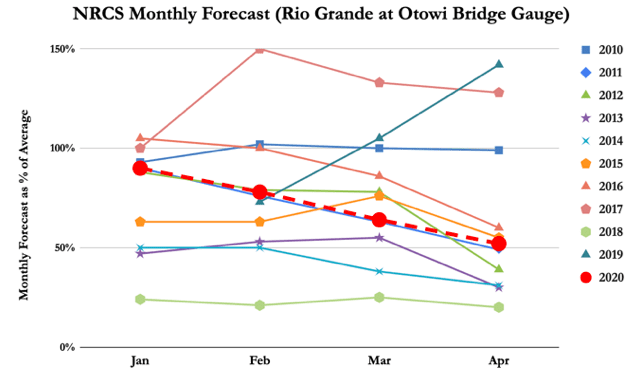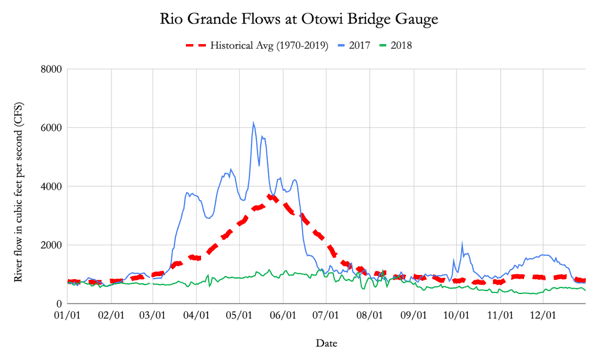Current work in wildlife, rivers, public lands, and climate
Press Releases
Low Flows Threaten Living Rio Grande in 2020
“The alarm bells are ringing once again for the health of the Rio,” said Galen Hecht, Rio Grande Campaigner at WildEarth Guardians. “If water users don’t cut back and leave water in the river, downstream users, communities, and environments will suffer. We all need a living Rio Grande.”
The NRCS releases Rio Grande forecasts monthly starting in January of each year. In the past decade of forecasts, only twice did the NRCS estimate above average flows at Otowi Bridge. The actual streamflow data confirms this trend.
Scientists have been warning for years that climate change will cause warmer temperatures in the Southwest that lead to reduced snowpack, earlier snowmelt, and declining streamflow. We are seeing this happen in real time.
The above graph shows the long term historical average (1970-2019) along with a wet year, 2017, and a dry year, 2018. In 2017 the Rio Grande experienced a pronounced and sustained spring pulse flow, which triggers spawning in endangered fish, provides overbanking flows to nourish the bosque and creates habitat for birds to nest.
In 2018, no such pulse flow occurred, largely due to the fact that the snowpack contained between just 10 percent and 30 percent of average moisture. In 2018 a large reach of the river dried up below Albuquerque starting in April. 2018 low flows had severe negative impacts on the ecosystem, including a 99.5 percent decline in the population of the endangered Rio Grande silvery minnow.
2020 snowpack data indicate that current snowpack moisture content is down to 67 percent of average. Drought persists in the Rio Grande Basin from around Albuquerque north through the headwaters in Colorado. In part the drought is a result of a lackluster monsoon in 2019, which was the third hottest and ninth driest monsoon season in the Southwest in a 125 year old record.
“The current public health crisis shows that people around the world can rally together when it counts,” commented Hecht. “A healthy environment supports healthy communities, and here in New Mexico, we need to better steward living rivers and clean water to achieve both.”

